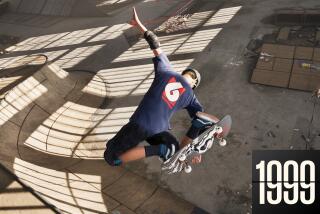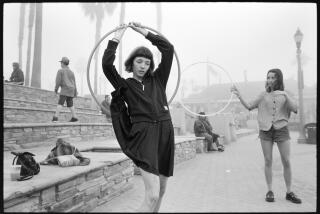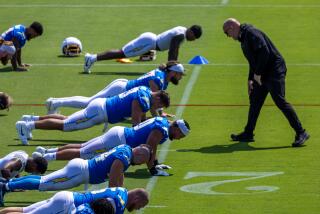Only the Obsessed Need Apply : This Summer Camp Is on a Roll
Give them a smooth stretch of concrete or the seductive curve of a wooden ramp, and the world is their oyster. They can “carve,” and they can “shred.” They can reach dizzying heights that would make their mothers cringe--if their mothers were permitted to watch.
Armed only with knee pads and a grim determination to get vertical, these boys of summer are smack in the middle of a very sweet obsession--skateboarding.
And at the Bobby G. Summer Skate Camp, on the tennis courts at San Diego State University, about 50 skateboard enthusiasts from all over the country are getting their fill--and then some.
Morning, noon and night, for the past five weeks, boys ranging in age from 8 to 22 have been following a rigorous regimen that would make a Marine Corps recruit flush. Now, in the final week of camp, the boys are perfecting the maneuvers they have learned, such as “snaking,” and “fakie rock and rolling.”
Summer Camp Routine
The Bobby G. program is like any other summer camp’s in many ways. There is the usual dormitory living, the army of counselors, the regular camp cuisine--candy bars, chocolate pudding and “killer” french fries. But there the similarity ends.
Each camp day begins with roll call at 7 a.m. sharp. After a hastily gobbled breakfast washed down with a GatorAid-like drink called Power Burst, its out to the ramps for half an hour of stretching and warm-up exercises. From there, campers break into groups and work for two hours with professional skateboarders.
There are more training sessions and free skate periods throughout the day, so that, by 8 o’clock at night, many of these kids have been on a skateboard more than 10 hours. Watching skating movies and videos of their daily routines caps off the evening nicely.
“It’s an obsession,” said Mike Ryan, owner of the Just Boards skate shop on the SDSU campus, which is supplying equipment and making repairs for the camp.
“These kids are 9 years old and younger, and they’re all serious about skating. They’ll skate all day long until it’s too dark to see outside,” he said.
Brendan Bates is one of the obsessed. The 13-year-old traveled all the way from Illinois to spend two weeks learning from the pros at Bobby G.’s.
‘Whiplash’ the First Week
“My mom said I could go to any camp I wanted, so I opened my skating magazine and gave it to her,” he said. “I went up the Whiplash the first week, but this week I’m going to learn everything else.”
And he’s not homesick one bit. “I love going away,” Bates said. Sorry mom.
David Morritt, a 13-year-old from Los Angeles, is another hardcore skater. This is his second year at the Bobby G. camp, and his one ambition this time is to learn how to “get really high on the half pipes.”
However, Ben Walsh, another 13-year-old from Los Angeles, is taking a more social stance to the camp. “I just came here to make friends and have fun, and because I like the ramps and pumping and doing kick turns,” he said.
“You can do whatever you want, nothing’s mandatory. If you want to learn tricks, you just watch the pros and ask them to show you how its done,” Walsh said.
The brains behind the camp are Bobby Goodsby and his half-brother, Clyde Reeves, both of Visalia. Goodsby had run a YMCA skate camp for 10 years, but became unhappy with the quality of instruction the campers were receiving.
Teamed with Reeves and brother-in-law Greg Riddle, Goodsby branched out and a skate camp last year at Fresno State University. Reeves said they moved the camp south because of the ideal weather and the number of professional skating teams already here.
‘Heart of Skateboarding’
“San Diego is the heart of skateboarding,” said Reeves, 22, and a veteran skater. “There is an incredible amount of teams and skateboard companies here . . . all through the week we have had pros who aren’t scheduled to teach, just drop in.”
The cost of the camp is $350 a week for campers who live in the dormitories at San Diego State, and $250 for skaters who choose not to sleep over. But, best of all, the price tag includes daily instruction from skating professionals.
“The camp is broken up into team-weeks, with different pros coming in every week,” Reeves said. “This week we had people from H. Street, a big company out of San Diego. They’ve been bringing in sponsors every night to check out the kids.”
A regular camp feature is professional skater Mark Partain. At 25 years old, the Ocean Beach resident says that teaching these kids their “dream tricks” makes him feel like a lad of 18 again.
“I’ll teach these guys anything they want to learn, from beginner to full-advanced,” he said. “Most of these kids can’t even go on the ramps, but, by the time they leave, they’re able to drop in the double ramp and go over the spine.”
Doug Boice, 19, a professional roller blader, is also a counselor/instructor at the camp. He says being a counselor is good instruction for him as well.
Learning Patience
“I’m way involved with the kids . . . skateboarding is something I can really relate to because I’ve been skating for the past 12 years,” Boice said. “I’m going to be a psych tech soon, and this camp is good training for me to learn to be patient with kids.”
On the huge wooden ramps set up within the fenced-in walls of the tennis court, the campers do get up close and personal with their idols. They are so busy learning from and skating with the pros from Blockhead, Vision Street Wear, Powell Peralta and H. Street Co., it keeps them out of trouble, Mike Ryan says.
“These kids are skating, getting their red badges of courage at this camp,” Ryan said. “They’re not smoking or stealing or doing drugs. They’re so involved in the sport, they keep out of trouble.” Well, not quite, according to Adam, a 14-year-old camper out of Spring Valley. “We let off a smoke bomb in the dormitory the other night, and then we tore out the smoke alarm because it was making too much noise.”
Hey, it’s SUMMER camp after all.
Otherwise, the campers have a perfect obedience record. They follow the strict rules laid out by the university and skate only inside the four walls of the tennis court. SDSU has had a skateboard ban on campus since 1985.
The agreement has worked well so far, said Reeves.
“At orientation, the first thing we make sure of is that our skateboarders understand that skating is prohibited on the campus except in the designated area,” he said. “We walk to and from our meals, and to the dorms and everywhere else.”
Limited Entry
For insurance purposes, only skaters and counselors are allowed in the domain of the tennis courts.
The constant supervision has also helped ward off skating accidents. In the five weeks of camp, there have been only two injuries--a sprained wrist and a broken tooth--aside from the never-ending skinned knees that come with the territory.
But a little skin and a little pain mean nothing to these boys. Given a chance, they would skate around the clock, working on their “dream tricks” and envisioning themselves one day on that big half-pipe of life.


